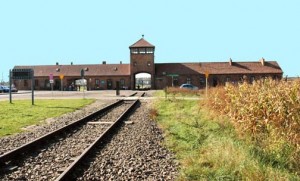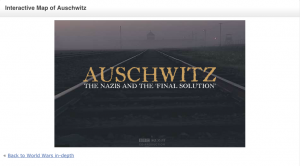Websites that include virtual tours allow you to empathize with the victims, of the Holocaust by allowing you to see where the victims were and what they saw. Virtual tours also allow you to see/ learn about the layout of locations including concentration camps without actually having to travel to those places.

Auschwitz Scrapbook
This website includes a virtual tour of the concentration camps: Auschwitz, Monowitz, and Oswiecim. Once you pick which location you want to view, you then can click on links to see the entrances, gates, gas chambers, etc. of each location through a series of hyperlinks. You have the choice of where you want to see/ “be” in the camp.
This website preserves the memory of the Holocaust by preserving the memory of three concentration camps built and used during the Holocaust. The virtual tours let users click on a series of hyperlinks in order to see the layout of the concentration camps and feel like you are walking through the concentration camps, while in your own home. You can choose which aspect of the Holocaust you want to learn about and see the layout of without actually having to travel to Europe.
A Teachers Guide to the Holocaust
This website presents a series of virtual tours of the Auschwitz concentration camp, including a tour of the Main Entrance, Gas Chamber, “Wall of Death,” and many more. When choosing a tour, AUS2S (1) such as this one of an Auschwitz gas chamber, AUS3S (1) or this one of the “Wall of Death” in Auschwitz. You have the choice to scroll where on that tour you want to “move” to and what you want to see/ learn about.
This website helps preserve the memory of the Holocaust by memorializing one of the largest and most famous concentration camps. The virtual tours allow people to see what Auschwitz looks like long after all of the buildings and fences are old and worn. Although the location can be cared for, how long will people try to keep the area kept? Photographs, videos, and virtual tours allow for the area to always look as it did during the Holocaust. This website allows you to learn about the different aspects of Auschwitz by seeing the layout of the camp, without actually having to visit the camp.
Virtual Auschwitz Map
BBC is a popular British news station. It’s not surprising that they had a unique interactive Auschwitz tour. The page it is on has been archived, this means it’s no longer on the main site, but its saved for general viewers in it’s archive. The tour starts by giving context to German policies towards Jews and then gets more detailed about Auschwitz. When describing the idea of concentration camps, the tour shows Europe maps, and maps of Auschwitz. This section of the BBC website is a good source for a visual learner as to how the final solution worked in relation to Auschwitz. This tour is part of even bigger section filled with more information about the Holocaust in general, that is not virtual but still important as it gives the viewer more choice after seeing the virtual tour.
Remembering Auschwitz
While many virtual tours of concentration camps, especially Auschwitz, exist; this site provides one of the most interactive. The tour actually allows the visitor to choose a site in the camp and navigate around a certain distance from that area. The experience is much like standing in a single spot on the camp and turning in circles to get a full view of the surrounding. A user may also choose to “walk” a short distance from the spot on which they entered the tour to get a slightly different perspective on the surroundings. This set up is the perfect example of the empathetic interaction the site is trying to elicit from the visitor. The site is getting you to feel like you’re actually standing in the camp where the victims were or what it would be like to stand there today and try to process all you’re seeing.